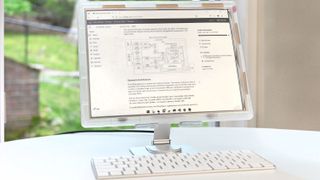New open-source, high resolution, low-latency E-ink monitor announced — Modos Paper delivers 1200p in a 13.3-inch form factor
The monitor is listed in pre-launch on Crowd Supply, alongside a Dev Kit that lets you BYOS

For those who deal with fatigue while looking at a screen, there's always paper. Modos Tech has officially announced the Crowd Supply pre-launch of its Modos Paper Monitor, which is an open-source E-ink display that also comes with a separate development kit for users who wish to use their own E-ink display with the Modos Paper's display controller.
This project is the brainchild of Alexander Soto, who describes a journey starting in February 2021 to defeat the eyestrain that comes with daily extended use of standard displays. When speaking to writers, programmers, students, doctors, engineers, other professionals, and those with health issues or impairments, he found many shared his name issue.
Working with Dave Crossland and Wenting Zhang, (aka @zephray_wenting who you may remember for documenting his adventures with a prison laptop), Soto successfully created his ideal monitor. Since its software and hardware are both open-sourced via GitHub, ambitious enough DIYers may be enabled to create this display or a similar display for themselves.
Modos Tech Paper Monitor Core Specs
- Panel Type: Monochrome E-Ink (optional Full-Color Panel also available)
- Refresh Rate: 60 Hz
- Screen Size: 13.3-inch
- Screen Resolution: 1600 x 1200
- Display Inputs: DVI over Micro HDMI, USB Type-C DisplayPort Alt-Mode
For many, the most important aspect may be the low latench. Modos is promising "a consistent < 120ms latency, compared to competitors, up to 270ms latency," which would make it pretty fast.
Modos Tech Paper Monitor Display Modes
- Black and White Binary Mode — Full 60 Hz refresh rate, sharpest image, and best response time, but no grayscale.
- Bayer Dithering Mode — Allows for some more middle gray tones but makes the text a little jaggier.
- Blue Noise Dithered Mode — Further improves grayscale but makes text yet jaggier. This mode is also best for video playback, though certainly not optimal for it.
- 4-Level Grayscale Mode — Seen as the ideal compromise between the extremes of Black and White and 16-Level grayscale. Considered ideal for web browsing, typing, etc.
- 16-Level Grayscale Mode — This is actually a "hybrid mode" that auto-switches between 16-Level grayscale and binary mode depending on page movement.
The Modos Paper Monitor does look pretty interesting, though we're still waiting for more solid information on a release window and pricing. E-Ink monitors can actually run a pretty premium, as proven by Dasung's Paperlike 253U which retails for $1,698 despite being a 25.3-inch monitor.
In any case, those who are interested can submit their information to the Modos Paper Monitor's Crowd Supply page to be kept in the loop for future updates. This does seem like a nice companion for those wanting to reduce their eyestrain, though its small size makes it seem more like a laptop companion than a desktop-appropriate display.
Stay On the Cutting Edge: Get the Tom's Hardware Newsletter
Get Tom's Hardware's best news and in-depth reviews, straight to your inbox.

Christopher Harper has been a successful freelance tech writer specializing in PC hardware and gaming since 2015, and ghostwrote for various B2B clients in High School before that. Outside of work, Christopher is best known to friends and rivals as an active competitive player in various eSports (particularly fighting games and arena shooters) and a purveyor of music ranging from Jimi Hendrix to Killer Mike to the Sonic Adventure 2 soundtrack.
-
artk2219 While that is still a slow refresh rate for a monitor, that thing is lightning fast compared to any ereader ive used in the past. Its seems like its actually pretty usable for typing and general scrolling while reading, now if only it were in color :D. It reminds me of LCD's from the early 2000's, I wonder what the end price will be on this one.Reply -
voyteck I'm afraid that the color version may still cause fatigue for some users compared to the standard one (or traditional books, for that matter) since I guess every pixel will still be represented by three subpixels set apart from each other, which in itself can be a source of eyestrain, at least for those affected by astigmatism.Reply
Most Popular


